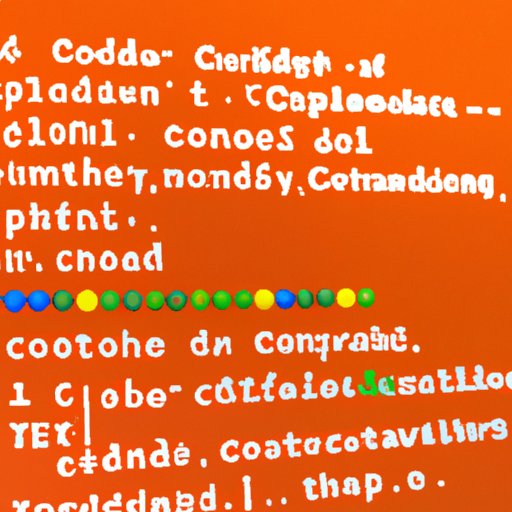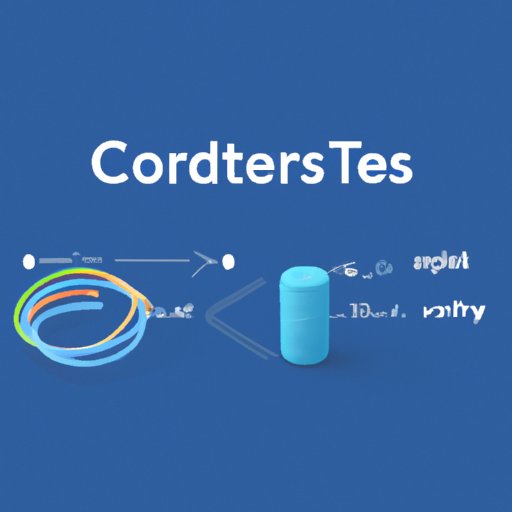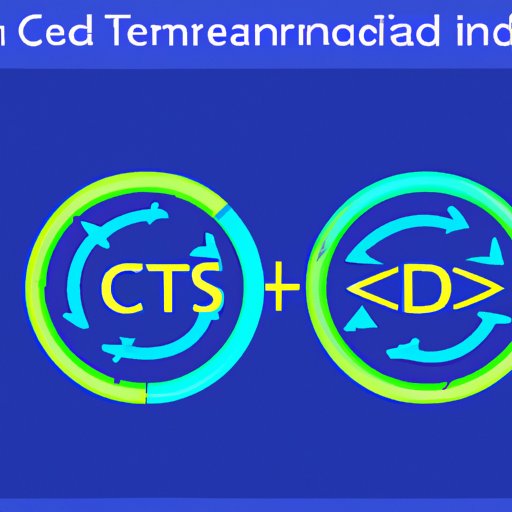Introduction
Threads are an effective way of improving application performance by allowing multiple processes to run simultaneously. They are lightweight processes that can be created and destroyed at any point in time. By creating multiple threads, a program can take advantage of the capabilities of multiple cores within a processor and execute tasks in parallel. This makes threading an important concept in modern computing.
In this article, we will explore the concept of threads in the C Programming Language. We will discuss what threads are and how they work, as well as provide a step-by-step guide on how to start a thread in C. We will also cover some of the more advanced concepts related to threading, such as locking mechanisms, synchronization techniques, and inter-thread communication.
Step-by-Step Guide on How to Start a Thread in C
Creating a thread in C is relatively straightforward. The following steps outline the basic process:
1. Creating the thread structure
The first step is to create a thread structure. This structure holds the necessary information about the thread, such as its ID, attributes, and the function it will execute. The following code snippet shows an example of how to create a thread structure:
pthread_t thread;
int ret;
ret = pthread_create(&thread, NULL, thread_function, NULL);
if (ret) {
printf("Error creating thread!\n");
exit(-1);
}
2. Setting the execution function
Once the thread structure has been created, the next step is to set the execution function for the thread. This is the function that will be executed when the thread is launched. The following code snippet shows an example of how to set the execution function:
void *thread_function(void *arg)
{
/* Your code goes here */
}
3. Setting the thread attributes
The third step is to set the thread attributes. This allows you to customize the behavior of the thread, such as its scheduling policy and priority. The following code snippet shows an example of how to set the thread attributes:
pthread_attr_t attr;
ret = pthread_attr_init(&attr);
if (ret) {
printf("Error setting thread attributes!\n");
exit(-1);
}
/* Set thread scheduling policy and priority */
ret = pthread_attr_setschedpolicy(&attr, SCHED_RR);
if (ret) {
printf("Error setting thread scheduling policy!\n");
exit(-1);
}
ret = pthread_attr_setschedparam(&attr, ¶m);
if (ret) {
printf("Error setting thread priority!\n");
exit(-1);
}
4. Launching the thread
Once the thread structure and attributes have been set, the next step is to launch the thread. This is done using the pthread_create() function. The following code snippet shows an example of how to launch a thread:
ret = pthread_create(&thread, &attr, thread_function, NULL);
if (ret) {
printf("Error launching thread!\n");
exit(-1);
}
5. Terminating the thread
Once the thread has completed its task, it should be terminated. This is done using the pthread_join() function. The following code snippet shows an example of how to terminate a thread:
ret = pthread_join(thread, NULL);
if (ret) {
printf("Error terminating thread!\n");
exit(-1);
}

An Overview of Threads in the C Programming Language
Threads are an important concept in modern computing, and they are heavily used in the C Programming Language. In this section, we will provide an overview of threads in C and discuss some of the basic operations associated with them.
What is a thread?
A thread is a lightweight process that can be created and destroyed at any point in time. It is a single flow of execution within a process and typically shares resources with other threads in the same process. Threads are used to improve the performance of applications by allowing them to take advantage of the capabilities of multiple cores within a processor and execute tasks in parallel.
Basic thread operations
Threads can be created, launched, terminated, and managed using various functions and data structures provided by the C standard library. The most commonly used functions and data structures are pthread_create(), pthread_join(), and pthread_t. These functions and data structures allow developers to create, launch, and terminate threads, as well as manage their attributes.
Working with threads in C
Threads can be used to improve the performance of applications, but they come with certain risks. To ensure that threads are safe and secure, developers must use synchronization techniques such as locking mechanisms and atomic operations. Additionally, developers must also use inter-thread communication techniques such as condition variables and message queues to ensure that threads are able to communicate with each other efficiently.

Working with Threads in C: A Comprehensive Guide
Threads are an essential concept in modern computing and are heavily used in the C Programming Language. In this section, we will provide a comprehensive guide on how to use threads in C, including an overview of locking mechanisms, synchronization techniques, and inter-thread communication.
Locking mechanisms
Locking mechanisms are used to ensure that only one thread at a time can access a shared resource. This prevents race conditions and ensures that the shared resource is accessed in a consistent manner. The C standard library provides several locking mechanisms, including mutexes, spinlocks, and semaphores.
Synchronization techniques
Synchronization techniques are used to ensure that threads are able to communicate with each other without any conflicts. This includes techniques such as barriers, which are used to synchronize the execution of multiple threads, and atomic operations, which are used to ensure that operations are performed in an atomic manner.
Inter-thread communication
Inter-thread communication is used to allow threads to communicate with each other. This includes techniques such as condition variables, which are used to allow threads to wait for a specific condition to be met, and message queues, which are used to send messages between threads.
Understanding Threads in C: A Beginner’s Guide
Threads are an important concept in modern computing, and they are heavily used in the C Programming Language. In this section, we will provide a beginner’s guide on how to understand threads in C, including an overview of what threads are, their states, and the different types of thread scheduling.
What are threads?
Threads are lightweight processes that can be created and destroyed at any point in time. They are used to improve the performance of applications by allowing them to take advantage of the capabilities of multiple cores within a processor and execute tasks in parallel.
Thread states
Threads can exist in various states, such as ready, running, blocked, and terminated. When a thread is created, it is placed in the ready state, which means that it is ready to be executed. When a thread is running, it is actively executing instructions. When a thread is blocked, it is waiting for a resource or event to occur. Finally, when a thread is terminated, it has finished executing and is no longer running.
Thread scheduling
Threads can be scheduled using various algorithms, such as round-robin, priority-based, and deadline-based scheduling. Round-robin scheduling is a simple algorithm that assigns each thread a fixed amount of time to execute before switching to the next thread. Priority-based scheduling assigns each thread a priority, and the thread with the highest priority is always executed first. Deadline-based scheduling assigns each thread a deadline, and threads are executed in order of their deadlines.
Creating Threads in C: A Tutorial
Creating threads in C is relatively straightforward, but there are some important concepts that must be understood. In this section, we will provide a tutorial on how to create threads in C, including an overview of initializing the thread, setting up the thread attributes, and executing the thread.
Initializing the thread
The first step in creating a thread is to initialize the thread structure. This structure holds the necessary information about the thread, such as its ID, attributes, and the function it will execute. The following code snippet shows an example of how to initialize a thread structure:
pthread_t thread;
int ret;
ret = pthread_create(&thread, NULL, thread_function, NULL);
if (ret) {
printf("Error creating thread!\n");
exit(-1);
}
Setting up the thread attributes
Once the thread structure has been initialized, the next step is to set up the thread attributes. This allows you to customize the behavior of the thread, such as its scheduling policy and priority. The following code snippet shows an example of how to set up the thread attributes:
pthread_attr_t attr;
ret = pthread_attr_init(&attr);
if (ret) {
printf("Error setting thread attributes!\n");
exit(-1);
}
/* Set thread scheduling policy and priority */
ret = pthread_attr_setschedpolicy(&attr, SCHED_RR);
if (ret) {
printf("Error setting thread scheduling policy!\n");
exit(-1);
}
ret = pthread_attr_setschedparam(&attr, ¶m);
if (ret) {
printf("Error setting thread priority!\n");
exit(-1);
}
Executing the thread
Once the thread attributes have been set up, the next step is to execute the thread. This is done using the pthread_create() function. The following code snippet shows an example of how to execute a thread:
ret = pthread_create(&thread, &attr, thread_function, NULL);
if (ret) {
printf("Error launching thread!\n");
exit(-1);
}
Getting Started with Threads in C: A Tutorial for Beginners
Threads are an important concept in modern computing, and they are heavily used in the C Programming Language. In this section, we will provide a beginner’s guide on how to get started with threads in C, including an overview of what threads are, thread safety, and creating and executing threads.
What are threads?
Threads are lightweight processes that can be created and destroyed at any point in time. They are used to improve the performance of applications by allowing them to take advantage of the capabilities of multiple cores within a processor and execute tasks in parallel.
Thread safety
When working with threads, it is important to ensure that they are safe and secure. This can be achieved by using synchronization techniques such as locking mechanisms and atomic operations. Additionally, developers must also use inter-thread communication techniques such as condition variables and message queues to ensure that threads are able to communicate with each other efficiently.
Creating and executing threads
Threads can be created and executed using various functions and data structures provided by the C standard library. The most commonly used functions and data structures are pthread_create(), pthread_join(), and pthread_t. These functions and data structures allow developers to create, launch, and terminate threads, as well as manage their attributes.

Using Threads in C: A Primer for Programmers
Threads are an important concept in modern computing, and they are heavily used in the C Programming Language. In this section, we will provide a primer on how to use threads in C, including an overview of multithreading concepts, implementing threads in C, and thread synchronization.
Multithreading concepts
Multithreading is the process of creating and managing multiple threads within a single process. It is used to improve the performance of applications by allowing them to take advantage of the capabilities of multiple cores within a processor and execute tasks in parallel.
Implementing threads in C
Threads can be implemented in C using various functions and data structures provided by the C standard library. The most commonly used functions and data structures are pthread_create(), pthread_join(), and pthread_t. These functions and data structures allow developers to create, launch, and terminate threads, as well as manage their attributes.
Thread synchronization
Thread synchronization is used to ensure that threads are able to communicate with each other without any conflicts. This includes techniques such as barriers, which are used to synchronize the execution of multiple threads, and atomic operations, which are used to ensure that operations are performed in an atomic manner.
Conclusion
Threads are an important concept in modern computing and are heavily used in the C Programming Language. In this article, we have explored the concept of threads in C and provided a step-by-step guide on how to start a thread in C. We have also covered some of the more advanced concepts related to threading, such as locking mechanisms, synchronization techniques, and inter-thread communication. With this knowledge, developers can create efficient and secure multithreaded applications in C.
(Note: Is this article not meeting your expectations? Do you have knowledge or insights to share? Unlock new opportunities and expand your reach by joining our authors team. Click Registration to join us and share your expertise with our readers.)
